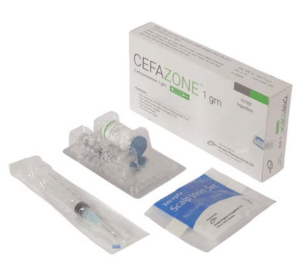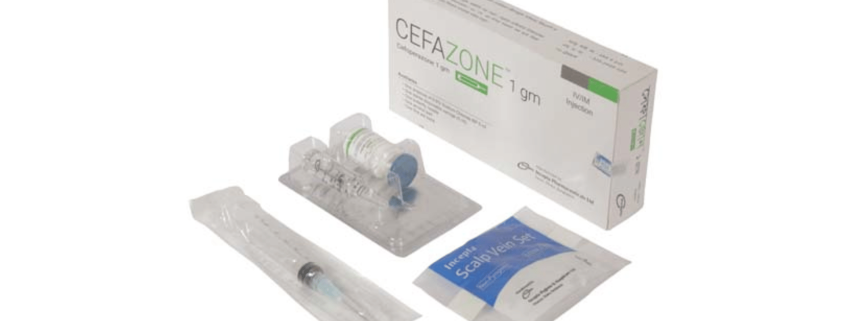CEFAZONE(Cefoperazone Sodium)

Therapeutic Group: Anti Bacterial
Presentation
Cefazone 1 gm IV/ IM injection: Each vial contains Cefoperazone sodium (Sterile Powder) USP equivalent to Cefoperazone 1 gm.
Cefazone 2 gm IV/ IM injection: Each vial contains Cefoperazone sodium (Sterile Powder) USP equivalent to Cefoperazone 2 gm
Description
Cefoperazone is a semisynthetic, broad-spectrum third-generation cephalosporin antibacterial drug. It interferes with cell wall synthesis by binding to the penicillin-binding proteins (PBPs), thus prevents cross-linking of nascent peptidoglycan. Cefoperazone is stable to penicillinases and has a high degree of stability to many beta-lactamases produced by gram negative bacteria.
Indications
Indications and usage
Cefoperazone is indicated for the treatment of the following infections when caused by susceptible organisms.
Respiratory Tract Infections caused by Streptococcus pneumoniae, Haemophilus influenzae, Staphylococcus aureus (penicillinase and non-penicillinase producing strains), Streptococcus pyogenes (Group A beta-hemolytic streptococci), Pseudomonas aeruginosa, Klebsiella pneumoniae, Escherichia coli, Proteus mirabilis, and Enterobacter species.
Peritonitis and Other Intra-abdominal Infections caused by Escherichia coli, Pseudomonas aeruginosa, and anaerobic gram-negative Bacilli (including Bacteroides fragilis).
Bacterial Septicemia caused by Streptococcus pneumoniae, Streptococcus agalactiae, Staphylococcus aureus, Pseudomonas aeruginosa, Escherichia coli, Klebsiella spp., Klebsiella pneumoniae, Proteus species (indole-positive and indole-negative), Clostridium spp. and anaerobic gram-positive Cocci.
Infections of the Skin and Skin Structures caused by Staphylococcus aureus (penicillinase and non-penicillinase producing strains), Streptococcus pyogenes, and Pseudomonas aeruginosa.
Pelvic Inflammatory Disease, Endometritis, and Other Infections of the Female Genital Tract caused by Neisseria gonorrhoeae, Staphylococcus epidermidis, Streptococcus agalactiae, Escherichia coli, Clostridium spp., Bacteroides species (including Bacteroides fragilis), and anaerobic gram-positive cocci.
Urinary Tract Infections caused by Escherichia coli and Pseudomonas aeruginosa.
Dosage & Administration
Adult:
The usual adult daily dose Cefoperazone is 2 to 4 grams per day administered in equally divided doses every 12 hours. In severe infections or infections caused by less sensitive organisms, the total daily dose and/or frequency may be increased. Patients have been successfully treated with
a total daily dosage of 6–12 grams divided into 2, 3 or 4 administrations. Usual duration of treatment is 7 to 14 days. In severe cases longer therapy may be required.
Pediatric:
Safety and effectiveness in children have not been established.
Geriatric:
Clinical experience has not identified differences in responses between the elderly and younger patients.
Direction for Reconstitution:
0.9% Sodium Chloride Injection (USP) can be used for the initial reconstitution for both intravenous and intramuscular use. Solution should be allowed to stand after reconstitution to allow any foaming to dissipate to permit visual inspection for complete solubilization. Vigorous and prolonged agitation may be necessary to solubilize cefoperazone in higher concentrations (above
333 mg cefoperazone/mL). The maximum solubility of cefoperazone is approximately 475 mg cefoperazone/mL of compatible diluent.
Preparation for Intravenous Use
Cefoperazone concentrations between 2 mg/mL and 50 mg/mL are recommended for intravenous administration. For ease of reconstitution the use of 5 mL of compatible solution per gram of cefoperazone is recommended. The entire quantity of the resulting solution should then be
withdrawn for further dilution and administration.
Compatible reconstituting solution appropriate for intravenous administration:
1. 5% Dextrose Injection (USP)
2. 5% Dextrose and 0.9% Sodium Chloride Injection (USP)
3. 5% Dextrose and 0.2% Sodium Chloride Injection (USP)
4. 10% Dextrose Injection (USP)
5. 0.9% Sodium Chloride Injection (USP)
Water for Injection is not to be used as a vehicle for intravenous infusion
The resulting intravenous solution should be administered in one of the following manners:
Intermittent Infusion: Solutions of cefoperazone should be administered over a 15–30 minute time period.
Continuous Infusion: Cefoperazone can be used for continuous infusion after dilution to a final concentration of between 2 and 25 mg cefoperazone per mL.
Side Effects
Hypersensitivity: As with all cephalosporins, hypersensitivity manifested by skin reactions, drug fever or a change in Coombs’ test has been reported. These reactions are more likely to occur in patients with a history of allergies, particularly to penicillin.
Hematology: As with other beta-lactam antibacterial drugs, reversible neutropenia may occur with prolonged administration. Slight decreases in neutrophil count, decreased hemoglobin or hematocrits and Transient eosinophilia have been reported.
Gastrointestinal: Diarrhea or loose stools with mild or moderate in severity has been reported and self-limiting in nature. Nausea and vomiting have been reported rarely. Symptoms of pseudomembranous colitis can appear during or for several weeks subsequent to antibacterial therapy.
Local Reactions: Cefoperazone is well tolerated following intramuscular administration. Occasionally, transient pain may follow administration by this route. When Cefoperazone is administered by intravenous infusion some patients may develop phlebitis at the infusion site.
Precautions
Cefoperazone is extensively excreted in bile. The serum half-life of Cefoperazone is increased 2–4 fold in patients with hepatic disease and/or biliary obstruction. In general, total daily dosage above 4 g should not be necessary in such patients. If higher dosages are used, serum concentrations should be monitored. In patients with both hepatic dysfunction and significant renal disease, Cefoperazone dosage should not exceed 1–2 g daily without close monitoring of serum concentrations.
Use in Pregnancy & Lactation
Pregnancy Category B: this drug should be used during pregnancy only if clearly needed. Only low concentrations of Cefoperazone are excreted in human milk. Although Cefoperazone passes poorly into breast milk of nursing mothers, caution should be exercised when Cefoperazone is administered to a nursing woman.
Drug Interaction
Solutions of cefoperazone and aminoglycoside should not be directly mixed, since there is a physical incompatibility between them.
Storage
Cefoperazone is to be stored at or below 30 degree C (86 F) and protected from light prior to reconstitution. After reconstitution, protection from light is not necessary. Keep out of the reach of children. Approximately 2 mg to 300 mg/mL concentrations of Cefoperazone provide stable solutions under the following conditions for the indicated time periods. (After the indicated time periods, unused portions of solutions should be discarded.)
1. If Room Temperature(15°–25°C/59 °–77°F) then indicated time periods 24 hours
2. If Refrigerator Temperature (2°–8 °C/36°–46°F) then indicated time periods 5 Days
3. If Freezer Temperature (–20 ° to –10 °C/–4° to 14°F) then indicated time periods 5 Weeks
Reconstituted Cefoperazone solutions may be stored in plastic syringes, or in flexible plastic parenteral solution containers. Frozen samples should be thawed at room temperature before use. After thawing, unused portions should be discarded. Do not refreeze.
Commercial Pack
Cefazone 1 gm IV/ IM injection: Each box has 1 vial containing Cefoperazone 1gm Powder for injection accompanied by one ampoule of 0.9% Sodium Chloride BP 5 ml, one sterile disposable syringe (5 ml), one butterfly needle, one alcohol pad & one first aid band.
Cefazone 2 gm IV/ IM injection: Each box has 1 vial containing Cefoperazone 2gm Powder for injection accompanied by one ampoule of 0.9% Sodium Chloride BP 10 ml, one sterile disposable syringe (10 ml), one butterfly needle, one alcohol pad & one first aid band.



